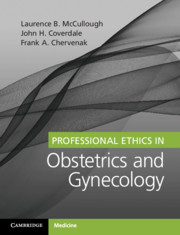Book contents
- Professional Ethics in Obstetrics and Gynecology
- Professional Ethics in Obstetrics and Gynecology
- Copyright page
- Dedication
- Contents
- Preface
- Acknowledgments
- Section 1 Professional Ethics in Obstetrics and Gynecology
- Section 2 Pedagogy of Professional Ethics in Obstetrics and Gynecology
- Section 3 Professionally Responsible Clinical Practice
- Chapter 7 Prevention of Pregnancy
- Chapter 8 Initiation of Pregnancy
- Chapter 9 Induced Abortion and Feticide
- Chapter 10 Fetal Analysis
- Chapter 11 Periviability
- Chapter 12 Intrapartum Management
- Chapter 13 The Perfect Baby
- Chapter 14 Cancer and Pregnancy
- Chapter 15 Setting Ethically Justified Limits on Life-Sustaining Treatment
- Section 4 Professionally Responsible Leadership
- Section 5 Professionally Responsible Innovation and Research
- Section 6 Professionally Responsible Health Policy and Advocacy
- Glossary of Key Concepts
- Index
- References
Chapter 12 - Intrapartum Management
from Section 3 - Professionally Responsible Clinical Practice
Published online by Cambridge University Press: 01 November 2019
- Professional Ethics in Obstetrics and Gynecology
- Professional Ethics in Obstetrics and Gynecology
- Copyright page
- Dedication
- Contents
- Preface
- Acknowledgments
- Section 1 Professional Ethics in Obstetrics and Gynecology
- Section 2 Pedagogy of Professional Ethics in Obstetrics and Gynecology
- Section 3 Professionally Responsible Clinical Practice
- Chapter 7 Prevention of Pregnancy
- Chapter 8 Initiation of Pregnancy
- Chapter 9 Induced Abortion and Feticide
- Chapter 10 Fetal Analysis
- Chapter 11 Periviability
- Chapter 12 Intrapartum Management
- Chapter 13 The Perfect Baby
- Chapter 14 Cancer and Pregnancy
- Chapter 15 Setting Ethically Justified Limits on Life-Sustaining Treatment
- Section 4 Professionally Responsible Leadership
- Section 5 Professionally Responsible Innovation and Research
- Section 6 Professionally Responsible Health Policy and Advocacy
- Glossary of Key Concepts
- Index
- References
Summary
This chapter provides an ethical framework to guide decision making about intrapartum management.
Most women deliver their babies vaginally. Vaginal delivery is clearly safer for the pregnant patient because no invasive clinical management is involved, even when fetal monitoring takes place. This clinical reality makes assisting vaginal delivery the default in clinical judgment, placing the burden of proof on justifying cesarean delivery. As a consequence, in traditional obstetric thinking, cesarean delivery is either indicated – the burden of proof is met – or nonindicated – the burden of proof is not met. When cesarean delivery is indicated, it should be recommended. When cesarean delivery is not indicated, it should not be offered, much less recommended.
- Type
- Chapter
- Information
- Professional Ethics in Obstetrics and Gynecology , pp. 147 - 162Publisher: Cambridge University PressPrint publication year: 2019



